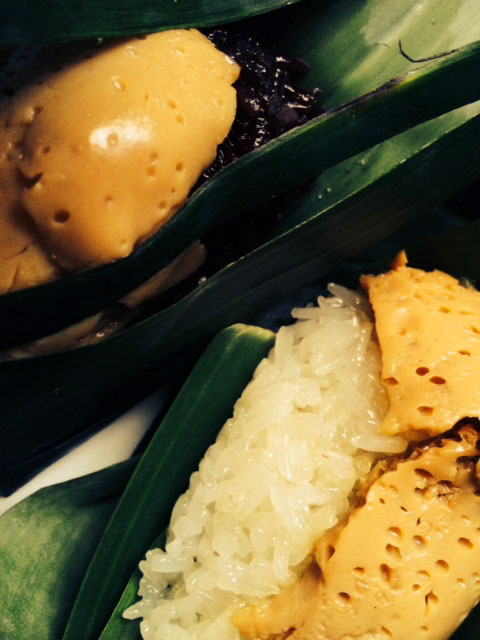THAI FOOD 101 — Thai food aficionados love to rhapsodize over stir-fried noodles and coconut-milk curries, but few sing the praises of the kingdom’s sweets ‒ the dumplings, jellies and nibbles that to many just look like 1,000 different ways to cook coconut, sticky rice and palm sugar.
So does one differentiate kanom thom from kanom chan?
Thai desserts, like the rest of Thai food, have undergone a sort of evolution over the past few centuries. Thai TV personality Chef McDang says the original Thai desserts revolved around the coconut and involved either boiling or steaming ‒ a cooking technique that was reserved expressly for sweets until the Chinese introduced Thais to steaming savory ingredients such as fish. Thus “floating something in coconut milk” (like gluay buat chee, or boiled bananas in coconut soup), boiling sticky rice flour dumplings (like kanom thom) or steaming coconut pudding (kanom toey) are considered “original Thai” because they involve traditional cooking techniques and bypass “foreign” ingredients such as eggs or flour.

Kanom chan
The ingredients used in making these desserts are like a revolving door of Thai-based favorites: bananas (and their leaves, popular for steaming purposes or as decorative containers); palm sugar (often made into a custard, or cooked with shredded coconut meat to form gracheek); sticky rice (or its flour for dumplings); and, obviously, coconut (or its milk and cream, to make absolutely everything else). The flavor profile that resulted was a mix of the sweet (palm sugar, fruit) with the savory (coconut cream) – a combination that would be echoed in desserts such as kanom mor gaeng (a sweet custard commonly topped with deep-fried shallots) and kanom bueng (a folded dessert crepe filled with meringue and, frequently, savory elements like shrimp or fish).
The arrival of the Portuguese in the 17th Century brought a new idea to Thai dessert-makers. Eggs could also be used for sweet purposes. This brought on a whole range of egg yolk-based sweets, eerily similar to the same types of sweets in Portuguese sweets shop windows: foy tong (golden threads), tong yip (golden blossoms) and tong yod (golden drops).
The Portuguese culinary adaptations didn’t end there. The miniature fruits and veggies known as look choop were adapted from Portuguese marzipan mini-fruits, except they were fashioned from mung bean paste instead of marzipan. And the popular dessert known as sankaya fuk tong (pumpkin stuffed with palm sugar custard) is also said to have been taken from a Portuguese recipe, adapted by Maria Guyomar de Pinha, a court cook of Portuguese-Japanese ancestry known as “Tao Tong Geeb Ma,” according to Chef McDang.

Khao niew sankaya
Today, Thai desserts can be roughly divided into a whopping seven categories (although some overlap):
1. Sticky rice-based (think khao niew sankaya or sticky rice with custard)
2. Coconut milk-based (like lod chong Singapore, or those wormy green squiggles made from rice flour floating in coconut milk)
3. Egg-based (think Portuguese-inspired favorites like the tong trio)
4. Syrup-based (Chinese-inspired treats like buay loy nam khing or sesame-stuffed dumplings in ginger syrup)
5. Jelly-based (Jello-y stuff like kanom chan)
6. Flour-based (like kanom toey foo, or Thai-style “cupcakes”)
7. Fruit-based (ever heard of khao niew mamuang? Or deep-fried bananas?)

A typical street sweets vendor’s table
This doesn’t even include wonderful things that may fall under the snack umbrella, such as I thim kai dip (vanilla ice cream mixed in with just-frozen raw egg yolk). And then there is my personal favorite, which could possibly involve any of the above categories (except for the egg or flour ones, because that would be weird), all mixed into delicious profusion.
What am I talking about? It’s nam kaeng sai, the Thai version of shaved ice desserts, which, like sausage, have mutated into a gazillion different variations all over the globe. Filipinos have halo-halo, the Japanese have kakigori, Hawaiians have, uh, “shave ice”, and the Thais have this dessert bar of rice flour dumplings, fruits and jellies run riot, meant to be mixed at will against a backdrop of either sweet coconut milk, longan juice or ginger syrup. Your finished masterpiece is then topped with a tiny pyramid of shaved ice, a sop to the overwhelming heat that blankets Bangkok roughly 360 days of the year.
It is easy to be overwhelmed when confronted with all these choices, so some common combinations are:
Thai-style: selim (multi-colored glass vermicelli), jackfruit, toddy palm fruit, coconut milk
Chinese-style: raak bua (lotus root), pa guay (gingko nuts), and pu sa jeen (Chinese red dates) with ginger syrup
My favorite: red jellies, mango, coconut jelly, coconut milk
Or you can just go to Seng Sim Ee in the Suan Luang Market near Sam Yan on Rama IV Road, where (if you can avoid the bees) the vendor will be happy to propose something to you.
More delicious reading from Thai Food 101:
What you wanted to ask about Thai Street Food but were afraid to know
Straight Outta Lanna: The khao soy connection
Just beat it: Laziness is killing our som tum flavor
If Game of Thrones was Thai street food
Satawesome or satawful: Reconsidering a troubled relationship with the stink bean
Catching the tail end of the summertime rice festival
Dr. Stinkfruit or: How to Stop Worrying and Love Durian
How to Yum: Make a tasty salad with whatever you got
Nam Prik 101: Is Thailand losing its pungent, chili paste heritage?





Reader Interactions